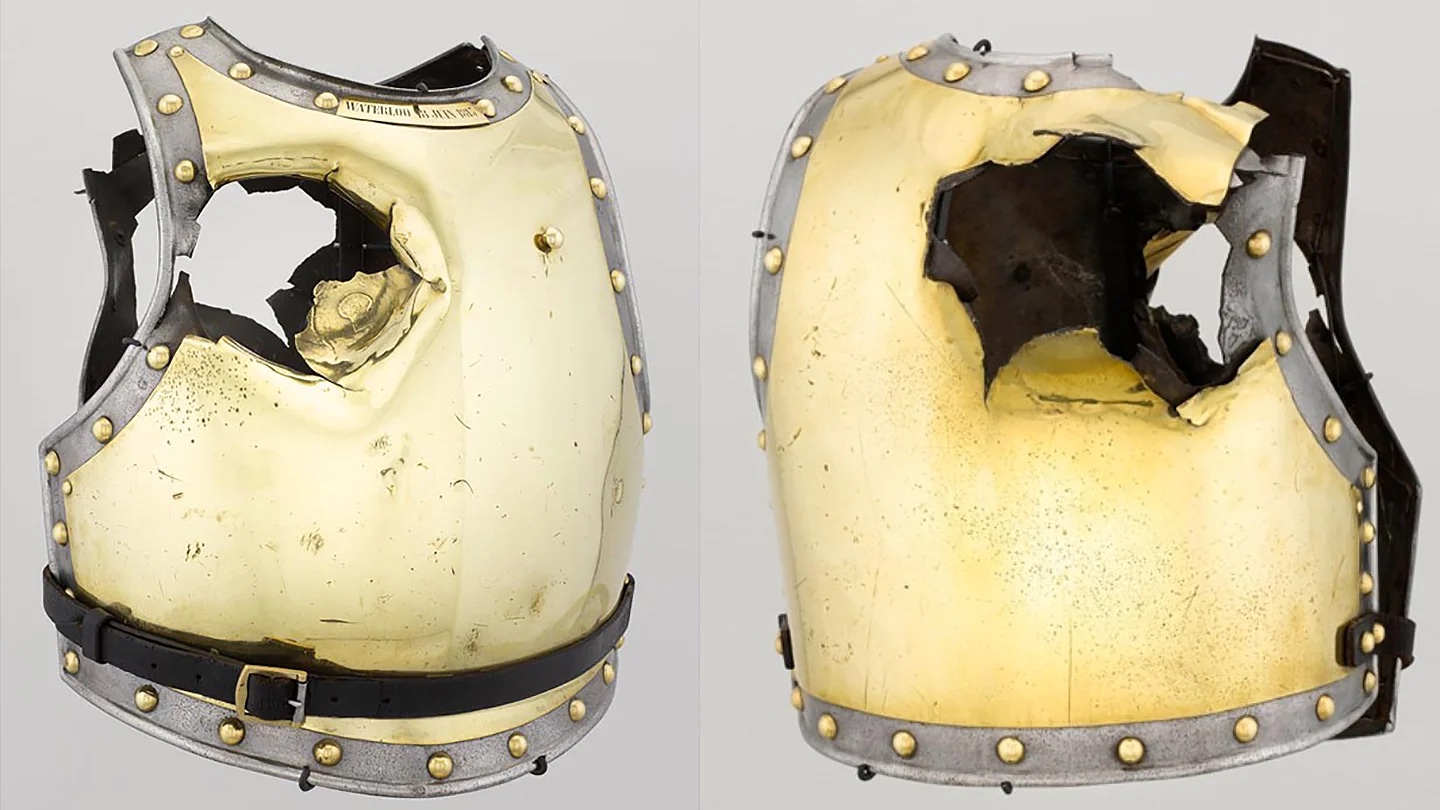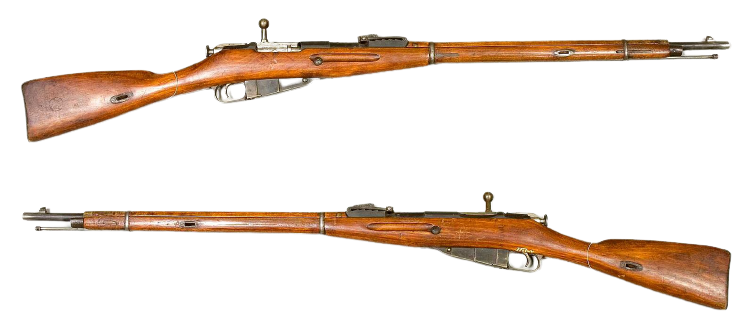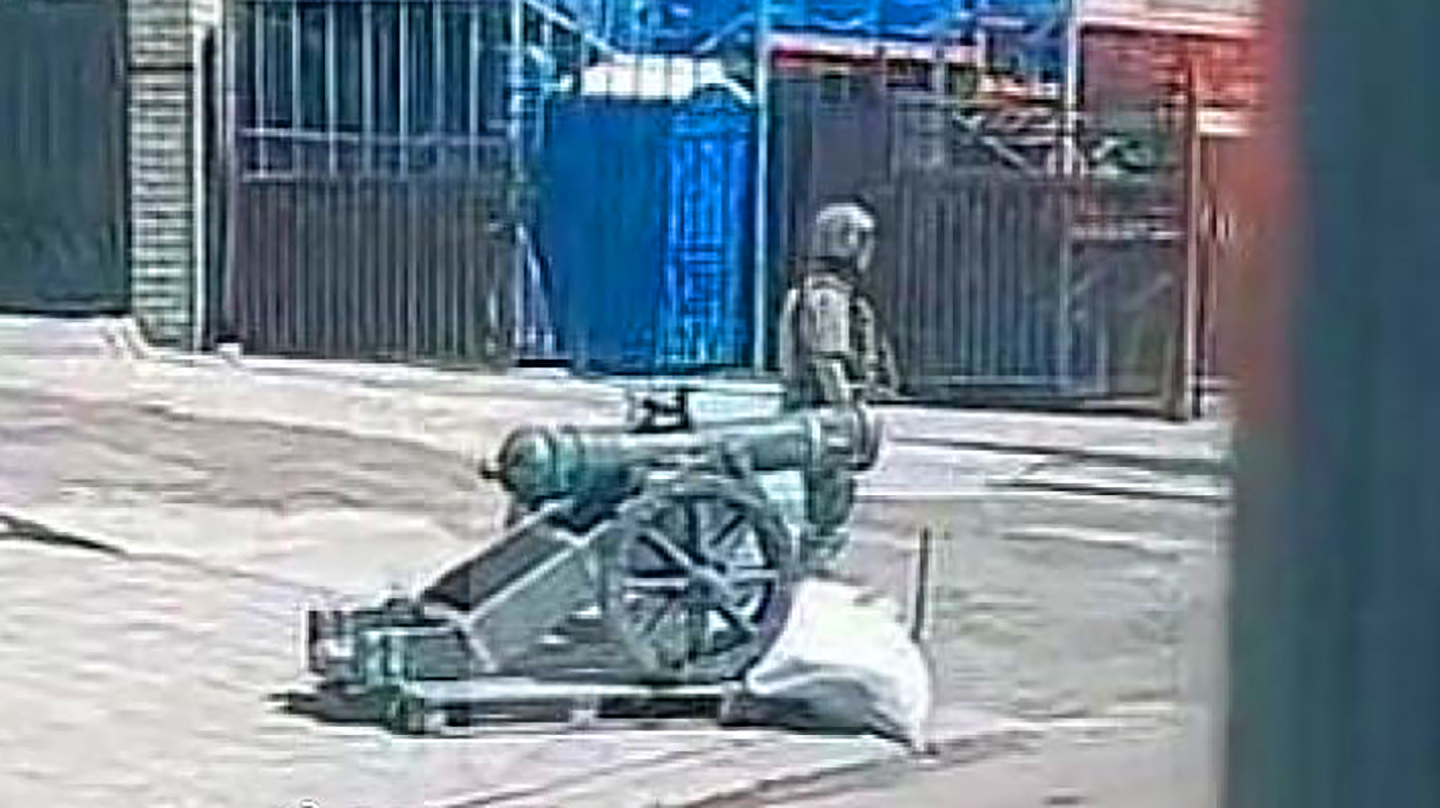Take it with a heap of salt, but what appears to be a muzzle-loading cannon straight out of the Napoleonic Wars — or a prop from a pirate movie — showed up at a supposed Russian checkpoint in the southern occupied Ukrainian city of Kherson. In a war with its share of absurdity and a healthy online meme machine, the whole thing could also be a joke playing up the perception of Russian forces as poorly equipped with antiquated weapons.
A Russian-speaking Telegram user named Dambiev posted a photo of the antique-looking artillery piece, mounted on a wheeled carriage and positioned on a street corner in Kherson on May 17. It’s unclear when the picture was taken. The caption, written in Russian, identifies a soldier standing nearby as a member of the Rosgvardia, the Russian National Guard, but the grainy image makes it impossible to determine if the soldier is a human being or a dummy.
The cannon is resting on a pallet with sandbags in front of the carriage wheels, so it was likely moved there and is not a memorial, statue, or some sort of fixture. If genuine, there is no way of knowing if the artillery piece is operational. It easily could have been looted from a museum or war memorial. It also is possible that the gun was placed there as a decoy to fool people passing through the checkpoint into believing there is a heavy weapon at that position. On the other hand, the tableau looks to be situated outside a corner shop, so it could also be a marketing display to draw in patrons.
If the cannon pictured in Kherson is a real-life weapon and still works, it is not clear how capable it would be, but could probably present some threat to personnel or unarmored vehicles. Loaded with black powder or some other propellant, the cannon could conceivably make a deadly projectile of anything crammed down its barrel.
Despite its apparent age and outdated technology, if the cannon is operational, you would still not want to be on the receiving end of a blast. Witness the mangled iron-and-brass cuirass worn by a soldier killed in 1815 at the battle of Waterloo. A solid, 4-inch-diameter shot struck the man in the chest and punched a massive hole through both plates of armor and his torso, killing him instantly. You can read more about the story behind the dramatic death of François-Antoine Fauveau, a 23-year-old Caribinier a Cheval, in this past War Zone feature.

It is impossible to tell from the lone photo how large a shot it could fire, and again, we don’t know if it even works. In working order, the gun would require specific training to operate safely and specialized implements for swabbing and packing the barrel between shots.
Elsewhere in Ukraine, late 19th century weapons are being fielded for certain. Separatist troops from the Luhansk and Donetsk Peoples Republics recently were seen shouldering pre-WWI-era, bolt-action Mosin Nagant rifles. Though the Nagant remains a relevant sniper weapon when equipped with modern optics, the separatist troops carried un-scoped versions of the weapon, first introduced in 1891. In a video that made the rounds on Twitter, a line of separatist troops is seen carrying the rifled and also wearing WWII-era steel helmets that offer less protection and comfort compared to their far more modern counterparts. Unencrypted, commercial-grade radios that are vulnerable to interception and jamming by Ukrainian and allied forces are also seen.
Other Russian-aligned separatist units are carrying Mosin-Nagants with Soviet-made PU scopes but using the rifles in a more specialist role makes somewhat more sense than handing them out as standard infantry rifles.
Reports from April found that morale in separatist units was abysmal. Aside from being issued Mosin rifles, troops told the Daily Beast they were ordered to fire mortars and automatic weapons in combat with little to no training. Some units have refused to fight, citing outdated gear and rotten food and water supplies.
It is unclear why Russia would not outfit these troops with older-model AK-47 assault rifles, of which there are about 75 million in the world. The Soviet Union manufactured millions of AK-family weapons during the Cold War and sent hundreds of thousands to proxies in Africa and the Middle East. It is likely that Russia still has some stockpiles of the iconic AKs. The Mosin also was one of the most-produced military rifles in history and are likely in large supply. The bolt-action Mosin, which comes in various lengths and configurations, including an optional foldable bayonet, has a five-shot internal magazine and is primarily chambered in 7.62x54mm, a more powerful cartridge than the 7.62X39mm round fired by the AK-47.

Russia is not the only combatant fielding weapons that to most eyes look straight out of a World War I documentary. Ukraine still fields a more-modern version of the M1910 Maxim machine gun patented in 1883. The same machine gun, a crew-served platform common to former Soviet states, has been seen in use by separatist troops in both Donetsk and Luhansk.
Ukrainian reserve units also are equipped with DP-27 light machine guns, a Soviet pan-fed design that predates World War II. Both the Maxim and DP-27s, though antiquated by modern standards, make more sense than the Mosin-Nagant because they are functional machine guns that fire readily available ammunition. These weapons have much greater utility on a battlefield flooded with modern automatic infantry weapons.
Russia’s army in Ukraine is better equipped than many of the defenders it faces, although that is changing as more advanced foreign arms flow into the country. Still, frontline Russian regulars are equipped with the more-modern AK-74 and AK-12 rifles, some of which have become Ukrainian trophies.
Regardless, the war continues to offer up a strange mix of the ancient and modern, like commercial drones dropping mortar rounds on trenches that are indistinguishable from those carved into the French countryside in World War I. The War Zone will continue to report on new and unique weapons that emerge during the conflict, including any further sightings of Civil War-era artillery pieces.
Contact the author: Dan@thewarzone.com
